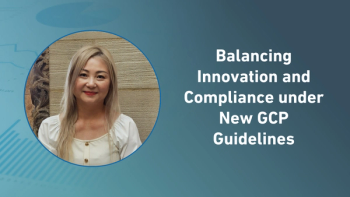
- Applied Clinical Trials-04-01-2013
- Volume 22
- Issue 4
Linking Leaders: Beyond the Boardroom
A view on redefining key roles across the evolving clinical development landscape.
Linking Leaders: The Clinical Roundtable Network was born two years ago to help clinical trial executives hold productive discussions on ways to spearhead innovation in the execution of clinical trials in an open and collaborative environment. The boardroom-style roundtables enable decision makers and influencers with responsibilities in clinical operations, clinical quality, and clinical outsourcing to share insights and experiences, benchmark progress, and brainstorm solutions with like-minded peers facing shared industry challenges. Filling a much needed gap in the conference/exhibition marketplace, Linking Leaders members get re-energized by spending one day each quarter with peers who help stimulate fresh perspectives and provide an experienced sounding board for both day-to-day and long-term challenges. Members agree that it is not only beneficial for the leaders around our boardroom table, but also in the best interests of patients to share learnings across the industry. This column highlights a theme that has been prominent across all Linking Leaders forums—deep concern over whether teams have the right skill sets, training, and behaviors to lead the next generation of clinical research—from an operational, outsourcing, and quality perspective.
Lesly Atlas
Clinical trial executives are increasingly strategizing around talent development, management, and retention and how they can develop future leaders within their organizations. As both a highly scrutinized regulatory environment and industry consolidation—on both the sponsor and provider side—took hold a few years ago, pharmaceutical companies have taken a hit in the area of human capital. From the challenges of transitioning to risk-based monitoring (RBM), to moving from micro management to true oversight, to creating the right roles within quality management systems (QMS), there is a growing trend around identifying key competencies since doing more with less is as prevalent as ever but with a renewed and laser-sharp focus on quality.
Pam Sobotka
The impact of risk-based monitoring and quality management systems
As new approaches to RBM begin to emerge across companies, executives are exploring ways to redefine roles for monitors and other personnel with comprehensive reviews of employee qualifications and training. Pilot programs are underway to evaluate the cost/benefit ratio of risk-based monitoring, with early results for some determining that the same level of quality was found as previously run studies run with 100% source data verification. Reducing data points in order to analyze what is truly critical is evolving the role of formerly box-checking monitors into site managers, provided they possess managerial qualities or can be professionally developed in this way. The transition from monitor to site manager is a cultural and change management issue for which leaders must be prepared. Significant culture change will also be required for companies considering moving data management under the auspices of clinical operations, as aligning these functions with the advent of electronic data capture can provide synergies. These synergies allow for potential decreases in personnel but require changes in thought process. "It comes down to a smart approach to managing data and marrying clinical operations and data management," says Mitchell Katz, Executive Director, Medical Operations at Purdue Pharma.
Clinical operations executives are also examining changing roles as their organizations transition to working within a QMS. While a quality management "system" might imply an inherent IT component, there is general agreement that it might best be referred to as a quality management "framework" to encapsulate the importance of the people within the system, rather than just the processes. This distinguishing factor was so important to small pharma company Pozen, they hired experts from a local university to train on how to pick the right employees and whether they'd be the right fit as they worked to incorporate quality by design approaches into clinical plans. "We need the most competent people; we can't afford to forget about the human factor," said Lisa Zimmerman, Pozen's Vice President of Clinical Operations.
The changing oversight function in an outsourced environment
As most companies are not increasing internal head count and continue to increase outsourcing, proper oversight of clinical service providers within a QMS is paramount. Andy Lee, Senior Vice President, Deputy Head, Clinical Sciences and Operations at Sanofi affirmed, "The days of doing it all on our own are over; without CRO alliances, we cannot be successful." Also, there is no consistent model that is considered best practice—it's not just FSP or full service any longer; it's all about fit-for-purpose. Linking Leaders roundtable members acknowledge that any given model can work but largely agree that it is the people you have on the project who are most critical. "Regardless of the model selected, we find the right individuals with the required credentials and strive to establish a collaborative environment with our clients up front," said Ray Hill, President of inVentiv Health Clinical. "Providing a project team that fits our clients' needs is our first priority."
An ongoing deliberation among executives is how much oversight of clinical service providers is enough and whether the term "oversight" is simply a more politically correct term for "micro management." With the FDA and global regulatory authorities routinely asking for oversight plans, sponsors attempt to walk the line between a more hands-off approach and appropriate oversight that meets regulatory expectations. This reexamination of the oversight function has led pharma companies to revisit both job descriptions and required training of their clinical teams; plus, a large part of oversight is behavioral—micro management as "habit." This conversion is challenging and requires a commitment to change management within the organization. Vendor management and oversight are competencies that can be learned, but training programs are needed to promote this skill set. Ultimately, senior management must advocate the changes that support the goal of transitioning from study management to vendor management without micro management.
Transforming the role of the QA professional within a QMS
Clinical quality executives believe in the human capital aspect so much that they are taking a hard look at redefining the "quality professional of the future." This is a result of both the recent characterization of quality by the FDA as "the absence of errors that matter" and the shifting mindset in pharma from one of compliance to one of quality as a culture. Historically, quality professionals have played a largely reactive audit role, focusing on verification and finding problems, as well as concentrating on minutiae to offer senior management the assurance that the site/system/vendor "passed the audit." Alternatively, the future state of audits should be aligned with a QMS and be proactive and solutions oriented. Therefore, the role of the quality assurance professional must evolve to reflect this both by encompassing an improved audit function and an expanded role that evaluates the big picture of quality within the organization, encompassing a continuum of quality planning, management, and improvement.
Technical skills, critical to an expanded quality professional, would include a current interpretive knowledge and deep understanding of regulations; a depth and breadth of knowledge of the drug development process; a sound foundation in ethics (including data privacy and the IRB process); an understanding of quality risk management skills, tools, and techniques; and a solid foundation in QMS. If an organization prefers to improve upon current auditor roles within the organization, additional training and development would be warranted. Deborah Driscoll, Vice President of Quality at Pfizer, believes "quality professionals should be proactively involved, in partnership with clinical and operations colleagues, in the process to align on what's critical to quality, and how best to manage the risks that are most likely to affect quality during a study. In turn, companies will garner the return on investment of building quality in up front and see the value of the integrated quality management plan approach."
An industry poised for change
Improving operational efficiencies, getting more value out of provider partnerships, and raising the bar on clinical quality have been perennial challenges for clinical trial executives. However, in light of a changing regulatory paradigm, cross-industry consortia, and new entities such as TransCelerate BioPharma, Inc. have emerged to initiate industry alignment and create more traction in improving the speed of delivering innovative drugs to market in a safe, efficient manner. Several Linking Leaders members are involved in these consortia and many are independently piloting programs within their own organizations. These executives are committed to sharing non-propriety information to help inform ways of improving quality, efficiency, and safety within clinical trials. It is invigorating to see leaders from companies, large and small, demonstrating openness and collaboration. Linking Leaders members are poised to drive important changes such as the evolving key roles discussed above and, in upcoming columns, we look forward to disseminating additional ideas and progress "beyond the boardroom."
Lesly Atlas, Founder, Linking Leaders, LLC
Pam Sobotka, Founder, Linking Leaders, LLC
Articles in this issue
over 12 years ago
Act coverover 12 years ago
FDA Promotes Quality and Risk Managementover 12 years ago
Personalized Medicineover 12 years ago
Collaboration Planningover 12 years ago
Standardization in Biospecimen Storage and Researchover 12 years ago
Business and People April 2013over 12 years ago
Act Insert Coverover 12 years ago
The Best-Laid Plans...Newsletter
Stay current in clinical research with Applied Clinical Trials, providing expert insights, regulatory updates, and practical strategies for successful clinical trial design and execution.






.png)



.png)



.png)
.png)
